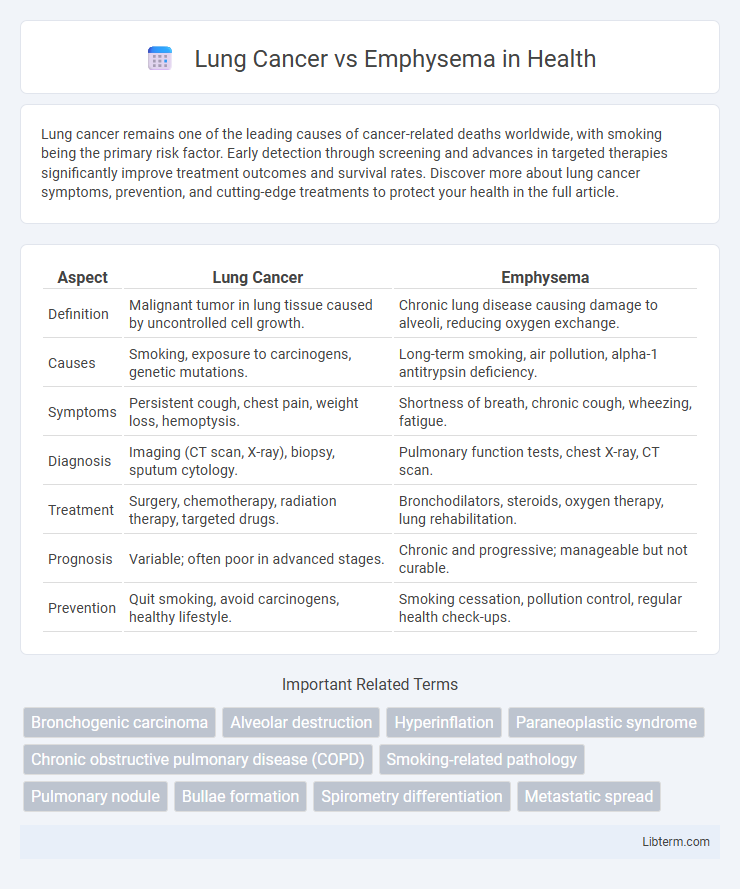Lung cancer remains one of the leading causes of cancer-related deaths worldwide, with smoking being the primary risk factor. Early detection through screening and advances in targeted therapies significantly improve treatment outcomes and survival rates. Discover more about lung cancer symptoms, prevention, and cutting-edge treatments to protect your health in the full article.
Table of Comparison
| Aspect | Lung Cancer | Emphysema |
|---|---|---|
| Definition | Malignant tumor in lung tissue caused by uncontrolled cell growth. | Chronic lung disease causing damage to alveoli, reducing oxygen exchange. |
| Causes | Smoking, exposure to carcinogens, genetic mutations. | Long-term smoking, air pollution, alpha-1 antitrypsin deficiency. |
| Symptoms | Persistent cough, chest pain, weight loss, hemoptysis. | Shortness of breath, chronic cough, wheezing, fatigue. |
| Diagnosis | Imaging (CT scan, X-ray), biopsy, sputum cytology. | Pulmonary function tests, chest X-ray, CT scan. |
| Treatment | Surgery, chemotherapy, radiation therapy, targeted drugs. | Bronchodilators, steroids, oxygen therapy, lung rehabilitation. |
| Prognosis | Variable; often poor in advanced stages. | Chronic and progressive; manageable but not curable. |
| Prevention | Quit smoking, avoid carcinogens, healthy lifestyle. | Smoking cessation, pollution control, regular health check-ups. |
Introduction to Lung Cancer and Emphysema
Lung cancer, characterized by uncontrolled cell growth in lung tissues, is a leading cause of cancer-related deaths worldwide. Emphysema, a chronic obstructive pulmonary disease (COPD), involves the gradual destruction of alveoli, leading to impaired respiratory function. Both conditions share risk factors such as smoking but differ significantly in pathology and treatment approaches.
Understanding Lung Cancer: Causes and Types
Lung cancer primarily develops due to genetic mutations caused by prolonged exposure to carcinogens such as tobacco smoke, radon gas, and asbestos. The two main types are non-small cell lung cancer (NSCLC), which accounts for approximately 85% of cases, and small cell lung cancer (SCLC), known for its aggressive nature and rapid growth. Understanding the distinct molecular pathways and risk factors of these types is crucial for targeted therapies and improving patient outcomes.
Emphysema Explained: Causes and Risk Factors
Emphysema, a chronic obstructive pulmonary disease (COPD), primarily results from long-term exposure to airborne irritants, especially cigarette smoke, which damages the alveoli in the lungs. Other significant risk factors include prolonged exposure to air pollution, chemical fumes, and genetic factors such as alpha-1 antitrypsin deficiency. This progressive lung condition reduces respiratory function by destroying the elasticity of lung tissue, leading to breathlessness and impaired oxygen exchange.
Key Differences Between Lung Cancer and Emphysema
Lung cancer involves malignant tumor growth in lung tissues, whereas emphysema is characterized by the destruction of alveoli leading to impaired gas exchange. Lung cancer symptoms often include persistent cough, chest pain, and hemoptysis, while emphysema primarily causes chronic shortness of breath and wheezing due to irreversible lung damage. Diagnostic methods for lung cancer include imaging and biopsy, whereas emphysema diagnosis relies on pulmonary function tests and high-resolution CT scans highlighting lung tissue damage.
Similarities in Symptoms: Overlapping Signs
Lung cancer and emphysema both present with overlapping symptoms such as chronic cough, shortness of breath, and chest discomfort, making early differentiation challenging. Patients may experience wheezing and fatigue in both conditions due to compromised lung function and tissue damage. Despite distinct underlying causes, these shared signs often necessitate thorough clinical evaluation and imaging to establish an accurate diagnosis.
Diagnostic Methods for Lung Cancer and Emphysema
Diagnosis of lung cancer primarily relies on imaging techniques such as chest X-rays and computed tomography (CT) scans, followed by biopsy procedures like bronchoscopy or needle biopsy to confirm malignant cells. Emphysema diagnosis involves pulmonary function tests (PFTs), including spirometry to measure airflow obstruction, and high-resolution CT scans to detect alveolar damage and lung tissue destruction. Both conditions often require a combination of clinical evaluation, radiological imaging, and histopathological analysis for accurate differentiation and diagnosis.
Treatment Options: Approaches for Each Condition
Lung cancer treatment options include surgery, chemotherapy, radiation therapy, targeted therapy, and immunotherapy, tailored based on cancer stage and type. Emphysema management focuses on smoking cessation, bronchodilators, corticosteroids, pulmonary rehabilitation, and oxygen therapy to improve lung function and quality of life. Surgical interventions such as lung volume reduction surgery or lung transplantation may be considered in severe emphysema cases, while lung cancer requires more aggressive oncologic treatments.
Prognosis and Life Expectancy Comparison
Lung cancer prognosis varies significantly based on stage at diagnosis, with early-stage non-small cell lung cancer patients having a five-year survival rate of approximately 63%, while advanced stages drop below 10%. Emphysema, a type of chronic obstructive pulmonary disease (COPD), typically presents a more gradual decline in lung function and life expectancy, with median survival ranging from 5 to 15 years depending on severity and comorbidities. Life expectancy in emphysema patients is generally longer than in late-stage lung cancer cases but can be significantly impacted by smoking status, lung function impairment, and treatment adherence.
Prevention Strategies and Risk Reduction
Smoking cessation remains the most critical prevention strategy for both lung cancer and emphysema, reducing exposure to carcinogens and irritants that damage lung tissue. Avoiding prolonged exposure to environmental pollutants, such as asbestos and radon, significantly lowers the risk of developing these chronic respiratory diseases. Regular health screenings and lung function tests aid in early detection, improving outcomes through timely intervention and management.
Living with Lung Cancer or Emphysema: Support and Resources
Living with lung cancer or emphysema requires comprehensive support systems including specialized medical care, pulmonary rehabilitation, and access to counseling services. Patient advocacy groups like the American Lung Association offer resources such as support groups, educational materials, and assistance programs tailored to lung disease management. Utilizing adaptive devices and home healthcare services can significantly improve quality of life and daily functioning for individuals coping with these chronic lung conditions.
Lung Cancer Infographic

 libterm.com
libterm.com